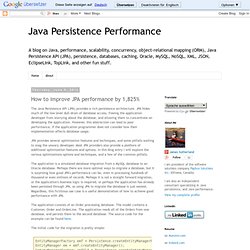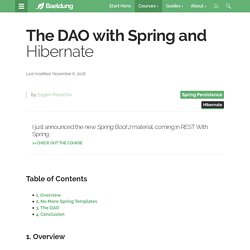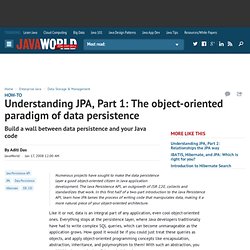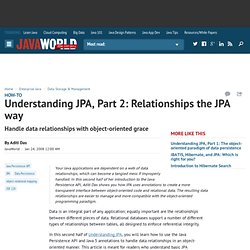

Maven and Hibernate 4 tutorial - Maven Hibernate-JPA. How to improve JPA performance by 1,825% The Java Persistence API (JPA) provides a rich persistence architecture.

JPA hides much of the low level dull-drum of database access, freeing the application developer from worrying about the database, and allowing them to concentrate on developing the application. However, this abstraction can lead to poor performance, if the application programmer does not consider how their implementation affects database usage. JPA provides several optimization features and techniques, and some pitfalls waiting to snag the unwary developer. Most JPA providers also provide a plethora of additional optimization features and options. In this blog entry I will explore the various optimizations options and techniques, and a few of the common pitfalls. The application is a simulated database migration from a MySQL database to an Oracle database. The application consists of an Order processing database.
The initial code for the migration is pretty simple: Optimization #1 - Agent Optimization #2 - Pagination. Java - JPA 2 Criteria Fetch Path Navigation. HowTo & Tutorial. JSF 2.1 and JPA 2 on Tomcat 7. Introduction I'm a JBoss user and so I tend to develop against and deploy on a JBoss server (JBoss 7.1 being awesome to the max).

But you know, sometimes I look at what I have and I think to myself: do I really *need* to apply all those layers of complexity just to solve a simple problem? Think about EJBs; powerful stuff, but is it really necessary to apply it when you are building a simple webapp? Even if JEE6 makes it simple by allowing you to deploy EJBs in the war, I still don't think so. Do you really need container managed stuff? In stead of plowing ahead and bolting on everything that other smart people come up with, sometimes it is just a good thing to take a step back and return to the basics. Please be aware that I'm not aiming here to teach you how to create web applications; that is a subject that filled many books. Setup tools Of course you need to download and install Tomcat 7 and you need Eclipse. The Persistence Layer with Spring 3.1 and Hibernate.
Table of Contents 1.

Overview This article will show how to implement the DAO with Spring and Hibernate. For the core Hibernate configuration, see the articles about Hibernate 3 and Hibernate 4 with Spring. 2. Starting Spring 3.0 and Hibernate 3.0.1, the Spring HibernateTemplate is no longer necessary to manage the Hibernate Session. As a consequence, it is now best practice to use the Hibernate API directly instead of the HibernateTemplate, which will effectively decouple the DAO layer implementation from Spring entirely.
UaiHebert (: Hello, how are you?

It is with a great joy that I announce a new version of the EasyCriteria framework. This new version will make easier and increase the framework utilization (click here if you do not know nothing about the EasyCriteria framework). 2 new features and a huge refactoring are present in this new version, these features/refactoring deserve a new major version in the framework. The new version is now 3.0. Let us see what is new: This refactoring was done to reduce the code complexity, to apply more code patterns, using “final” attribute to make a better memory use and changing “pom.xml” dependences. Understanding the Java Persistence API, Part 1. Numerous projects have sought to make the data persistence layer a good object-oriented citizen in Java application development.

The Java Persistence API, an outgrowth of JSR 220, collects and standardizes that work. In this first half of a two-part introduction to the Java Persistence API, learn how JPA tames the process of writing code that manipulates data, making it a more natural piece of your object-oriented architecture. Like it or not, data is an integral part of any application, even cool object-oriented ones.
Everything stops at the persistence layer, where Java developers traditionally have had to write complex SQL queries, which can become unmanageable as the application grows. How good it would be if you could just treat these queries as objects, and apply object-oriented programming concepts like encapsulation, abstraction, inheritance, and polymorphism to them!
Understanding the Java Persistence API, Part 2: Relationships the JPA way. Your Java applications are dependent on a web of data relationships, which can become a tangled mess if improperly handled.

In this second half of her introduction to the Java Persistence API, Aditi Das shows you how JPA uses annotations to create a more transparent interface between object-oriented code and relational data. The resulting data relationships are easier to manage and more compatible with the object-oriented programming paradigm. Data is an integral part of any application; equally important are the relationships between different pieces of data.
Spring 3.0 and Hibernate tutorial (part 1) « Me and my chaotic life.